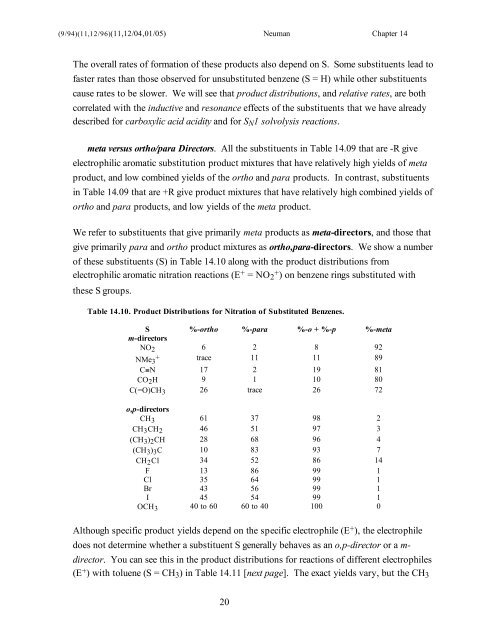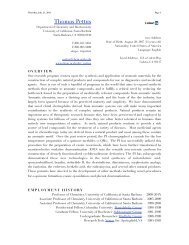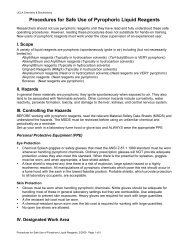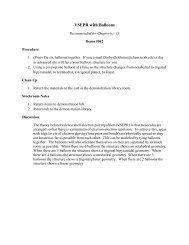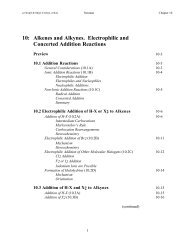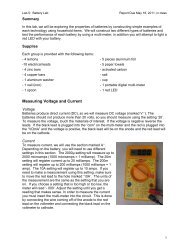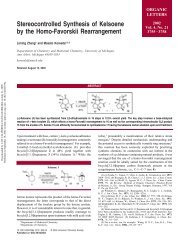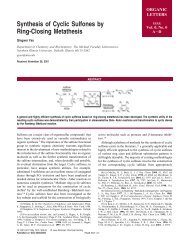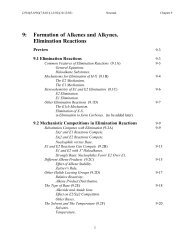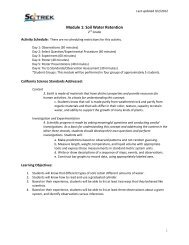14: Substituent Effects
14: Substituent Effects
14: Substituent Effects
You also want an ePaper? Increase the reach of your titles
YUMPU automatically turns print PDFs into web optimized ePapers that Google loves.
(9/94)(11,12/96)(11,12/04,01/05) Neuman Chapter <strong>14</strong><br />
The overall rates of formation of these products also depend on S. Some substituents lead to<br />
faster rates than those observed for unsubstituted benzene (S = H) while other substituents<br />
cause rates to be slower. We will see that product distributions, and relative rates, are both<br />
correlated with the inductive and resonance effects of the substituents that we have already<br />
described for carboxylic acid acidity and for SN1 solvolysis reactions.<br />
meta versus ortho/para Directors. All the substituents in Table <strong>14</strong>.09 that are -R give<br />
electrophilic aromatic substitution product mixtures that have relatively high yields of meta<br />
product, and low combined yields of the ortho and para products. In contrast, substituents<br />
in Table <strong>14</strong>.09 that are +R give product mixtures that have relatively high combined yields of<br />
ortho and para products, and low yields of the meta product.<br />
We refer to substituents that give primarily meta products as meta-directors, and those that<br />
give primarily para and ortho product mixtures as ortho,para-directors. We show a number<br />
of these substituents (S) in Table <strong>14</strong>.10 along with the product distributions from<br />
electrophilic aromatic nitration reactions (E + = NO2 + ) on benzene rings substituted with<br />
these S groups.<br />
Table <strong>14</strong>.10. Product Distributions for Nitration of Substituted Benzenes.<br />
S %-ortho %-para %-o + %-p %-meta<br />
m-directors<br />
NO2 6 2 8 92<br />
NMe3 + trace 11 11 89<br />
C≡N 17 2 19 81<br />
CO2H 9 1 10 80<br />
C(=O)CH3 26 trace 26 72<br />
o,p-directors<br />
CH3 61 37 98 2<br />
CH3CH2 46 51 97 3<br />
(CH3)2CH 28 68 96 4<br />
(CH3)3C 10 83 93 7<br />
CH2Cl 34 52 86 <strong>14</strong><br />
F 13 86 99 1<br />
Cl 35 64 99 1<br />
Br 43 56 99 1<br />
I 45 54 99 1<br />
OCH3 40 to 60 60 to 40 100 0<br />
Although specific product yields depend on the specific electrophile (E + ), the electrophile<br />
does not determine whether a substituent S generally behaves as an o,p-director or a m-<br />
director. You can see this in the product distributions for reactions of different electrophiles<br />
(E + ) with toluene (S = CH3) in Table <strong>14</strong>.11 [next page]. The exact yields vary, but the CH3<br />
20


